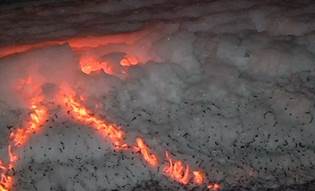|
|
ENVIS Technical Report 108, March 2017 |
FOAMING OR ALGAL BLOOM IN WATER BODIES OF INDIA: REMEDIAL MEASURES - RESTRICT PHOSPHATE (P) BASED DETERGENTS
|
| T.V. Ramachandra Durga Madhab Mahapatra Asulabha K S
Sincy Varghese |
Energy & Wetlands Research Group, Centre for Ecological Sciences,
Indian Institute of Science, Bangalore, Karnataka, 560 012, India.
E Mail: cestvr@ces.iisc.ernet.in,
Tel: 91-080-22933099, 2293 3503 extn 101, 107, 113
|
summary
Algal bloom or foaming is a consequence of nutrient enrichment (N and P) due to untreated sewage (mostly from human and household waste and detergents) and industrial effluents. The phosphorus from several sources reaching water bodies causes pollution leading to algal blooms, frothing, etc. Phosphorus represents both a scarce non-renewable resource and a pollutant for living systems.
Primary nutrient, such as carbon, nitrogen, phosphorus, etc. contribute to eutrophication. In fresh water ecosystem, primary producers are able to obtain N from the atmosphere and hence phosphorus is the primary agent of eutrophication. Moreover, elements carbon, nitrogen and phosphorus can generate its weight by 12, 71 and 500 times, and hence phosphorous is the limiting element in primary producers. Nutrients enrichment often leads to profuse growth of invasive species (water hyacinth, etc.), which forms thick mat hindering the sunlight penetration. In absence of sunlight, photosynthetic activities cease affecting the food chain. Absence of sunlight penetration leads to the decline of primary producers (algae) in the region below the macrophyte mat. Most part of nitrogen available in the sewage and industrial effluents is assimilated by producers, while phosphorous gets trapped in the sediment. During pre-monsoon with high intensity winds, churning of lake water happens, leading to the release of phosphorous from sediments forming froth. Foaming is the manifestation of interactions among air bubble, surfactant and hydrophobic particles. The hydrophobic particles congregate at the air-water interface and strengthen the water film between air bubbles. Meanwhile, the particles also serve as collector for surfactant which stabilizes the foam. Surfactants contain slowly biodegradable surfactants and hydrophobic particles are the filamentous bacteria with a long-chain structure and hydrophobic surface. Thus, frothing is due to the presence of slowly biodegradable surfactants (eg. household detergents) from industrial or municipal wastewater, excess production of extracellular polymeric substance (by microorganisms, proliferation of filamentous organisms) and air bubble (wind).
Constituents of Detergents: The surfactant nonylphenol ethoxylate (NPE), an endocrine disruptor and estrogen mimic; phosphates, which help remove minerals and food bits but cause harmful algal blooms in waterway. |
Chemical analyses of field samples reveal that, foams are enriched with particulate organic and inorganic compounds such as nutrients (Nitrogen, Phosphorus and Carbon), cations (Sodium, Potassium, Calcium and Magnesium). Foam generated is normally sticky and white in color. Most surfactants originate from the detergents, oil and grease that are used in households or industry. Surfactant could stabilize the foaming and allow foam to accumulate.
Physico-chemical parameters of water and foam samples from Varthur lake (01/05/2015)
Parameters |
V1 |
V2 |
Foam |
Water temperature (0C) |
27.1 |
26.9 |
27.2 |
TDS (mg/l) |
448 |
454 |
7000 |
EC (µS) |
749 |
764 |
17000 |
pH |
7.46 |
7.35 |
6.98 |
DO (mg/l) |
2.6 |
0 |
- |
BOD (mg/l) |
24.39 |
60.98 |
650.41 |
COD (mg/l) |
40 |
88 |
1140 |
Alkalinity (mg/l) |
336 |
336 |
12000 |
Chloride (mg/l) |
117.86 |
122.12 |
3195 |
Total Hardness (mg/l) |
206 |
224 |
13000 |
Ca Hardness (mg/l) |
57.72 |
64.13 |
3607.2 |
Mg Hardness (mg/l) |
36.03 |
38.85 |
2282.45 |
Phosphate (mg/l) |
1.263 |
0.881 |
74.59 |
Nitrate (mg/l) |
0.541 |
0.361 |
129.72 |
Sodium |
169.5 |
161 |
770 |
Potassium |
35 |
34 |
230 |
|
Algal Bloom: due to Nutrient enrichment in lentic ecosystem
Foam/Frothing: Nutrient enrichment in lotic ecosystems and in lentic ecosystem (with movement of water). |
Fire associated with foam in Bellandur lake (@ Yamalur):
Flammability is the ability of a substance to burn or ignite, causing fire or combustion. Incidences of foam catching fire are due to compounds with high flammability i.e. (i) mostly hydrocarbons and organic polymers from nearby industries in the vicinity of Bellandur lake and (ii) phosphorous from detergents. High wind coupled with high intensity of rainfall leads to upwelling of sediments with the churning of water as it travels from higher elevation to lower elevation forming froth due to phosphorous. Discharge of untreated effluents (rich in hydro carbon and phosphorous) with accidental fire (like throwing cigarettes, beedi) has led to the fire in the lake. Colour of the flame and subsequent analyses of black particles (burnt residues) confirms the source (long chain hydro carbons).
  |
Phosphorus (P) is one of the nutrients essential to sustain biota on the Earth and is a non-renewable resource. The indiscriminate exploitation and abuse of this resource is threatening the sustenance and its availability for future generations is becoming obscure. There has been a series of events (frequent frothing, etc. in water bodies) and subsequent research have clearly highlighted the linkages of enhanced usage and influx of P with a phenomenal increase in P enrichment in surface and ground waters. Consequence of extensive phosphorus usage in contemporary urban societies is the nutrient enrichment or eutrophication of water bodies. Studies across the globe highlight of nearly 2.4–2.7-fold increase in nitrogen and phosphorus driven eutrophication of freshwater and marine ecosystems with the current level of human-induced stresses. The main sources of phosphate in aquatic environment, is through household sewage water containing detergents and cleaning preparations, agricultural run-off containing fertilizers, as well as, industrial effluents from fertilizer, detergent and soap industries.
The consumption of synthetic detergents is rapidly increasing with urbanisation and most of them contain phosphate as a ‘builder’, which has been increasing phosphate loading in water bodies. The estimated annual consumption of phosphate-containing laundry detergents for the current population in India is about 2.88 million tonnes and the total outflow of P is estimated to be 146 thousand tonnes per year. The environmental consequences necessitate immediate policy interventions for checking eutrophication of water bodies, through reduction in Phosphate based detergents and hence P inputs to surface waters. All the detergent manufacturers need to adhere to minimise the use of P in the manufacture of detergents while the authorities need to restrict with stringent norms. Strict control with the vigilant and environmentally conscious public only could ensure that Indian water bodies remain safe and healthy.
During seventies and early eighties, 19th century such instances had brought about an increase in global consensus and the public awareness mostly in the European nations and triggered regulations on P loads from Industry and Urban sources. In India there has been a widespread use of P based detergents that has resulted in contamination of ground and surface waters rendering the water unsuitable for any use. One of the major constituents that form a bulk of the detergents is the builder material that is often made up of Sodium tripolyphosphate (STPP) that significantly contributes to P enrichment. The levels of P enrichment in urban water systems is enormous ranging from 0.5 to >10 mg/l of labile P. Abundant P in these systems have substantially contributed to increased biomass productivity and a leap in the net primary productivity of the urban aquatic systems that ahs resulted in rampant proliferation of aquatic macrophytes and weeds at the same time aided in the large scale algal blooms often seen sin the surfaces of these urban water bodies. The sludge P values in the initial reaches of the wastewater fed water bodies like Bellandur is ~1-3 %. During shifts in redox environments these P becomes bioavailable and results in increased primary productivity of the system. The sediment P levels varies from 0.1 – 0.28 %, mostly as NaOH soluble P forms indicating high fraction of mineralisable P in these lake systems. Two main solutions for cutting short rapid and high P influx into the system is a) Introduction of non-P based builders in detergents for example Zeolite, that can completely replace Sodium tripolyphosphates (STPP - amounts to ~50% bio-available P in municipal wastewaters) commonly seen in detergents and b) Augmenting the existing wastewater treatment system for nutrient removal and recovery. This requires various measures that aids in framing and implementatation of laws to completely replace P based builders to alternative non-P based household laundry detergents. Already the European Commission (EC) has implemented non-P based culture in detergents through the European Union (EU) and recommends appropriate measures to improve the present P enrichment scenario. The two main essential P sources in urban conglomerates are the municipal wastewaters and to a lesser extent agriculture. In most of the Bangalore’s catchment that has an inadequate treatment facility and treatment is mostly up to tertiary levels. Municipal wastewaters represent the single largest P source in urban municipalities. In case of certain areas where people practice agriculture, horticulture and floriculture, a minute amount of P (synthetic fertilisers) escapes from these landscapes, where top soil erosion and land run off are the crucial means of entry of fertiliser P into the channels and freshwater lakes. It has been estimated that P from detergents contributes to an estimated 65% of P in municipal wastewaters and the rest are from excrements etc. Based on the field sample analyses, the recommendations are a) A ban on production of polyphosphate based detergents in Indian systems which will help in usage of trusted non-P based detergents, that would bring down the P loads contributed from detergents in municipal wastewaters and also significantly reduce P loads from all garment, textile and other industries that uses detergents substantially; b) Nutrient removal and recovery mechanisms to be augmented into the existing treatment systems by the help of phyto-phyco modules.
The study highlights the need for immediate intervention towards the reduction in the amount of sodium tripolyphosphate (STPP) used in detergent builders and switch to ‘alternative’ non-phosphate based builders, such as Zeolite A; and, improving wastewater treatment taking advantage of constructed wetlands in urban wastewater treatment.
Keywords: Lakes, water bodies, nutrient enrichment, eutrophication, detergents, phosphorous
|
|
Dr. T.V. Ramachandra
Centre for Sustainable Technologies, Centre for infrastructure, Sustainable Transportation and Urban Planning (CiSTUP), Energy & Wetlands Research Group, Centre for Ecological Sciences, Indian Institute of Science, Bangalore – 560 012, INDIA.
E-mail : cestvr@ces.iisc.ernet.in
Tel: 91-080-22933099/23600985,
Fax: 91-080-23601428/23600085
Web: http://ces.iisc.ernet.in/energy
Durga Madhab Mahapatra Energy & Wetlands Research Group, Centre for Ecological Sciences, Indian Institute of Science, Bangalore – 560 012, INDIA.
E-mail: durgamadhab@ces.iisc.ernet.in
Asulabha K SEnergy & Wetlands Research Group, Centre for Ecological Sciences, Indian Institute of Science, Bangalore – 560 012, INDIA.
E-mail: asulabha@ces.iisc.ernet.in
Sincy VargheseEnergy & Wetlands Research Group, Centre for Ecological Sciences, Indian Institute of Science, Bangalore – 560 012, INDIA.
E-mail: sincy@ces.iisc.ernet.in
Citation:Ramachandra T V, Durga Madhab Mahapatra, Asulabha K S, Sincy Varghese, 2017. Foaming or Algal Bloom in Water bodies of India: Remedial Measures - Restrict Phosphate (P) based Detergents, ENVIS Technical Report 108, Environmental Information System, CES, Indian Institute of Science, Bangalore 560012.
| Contact Address : |
| |
Dr. T.V. Ramachandra
Energy & Wetlands Research Group,
Centre for Ecological Sciences, TE 15, New Biology Building, Third Floor, E Wing, [Near D Gate], Indian Institute of Science, Bangalore – 560 012, INDIA.
Tel : 91-80-22933099 / 22933503-extn 107
Fax : 91-80-23601428 / 23600085 / 23600683 [CES-TVR]
E-mail : cestvr@ces.iisc.ernet.in, energy@ces.iisc.ernet.in,
Web : http://wgbis.ces.iisc.ernet.in/energy |
|

